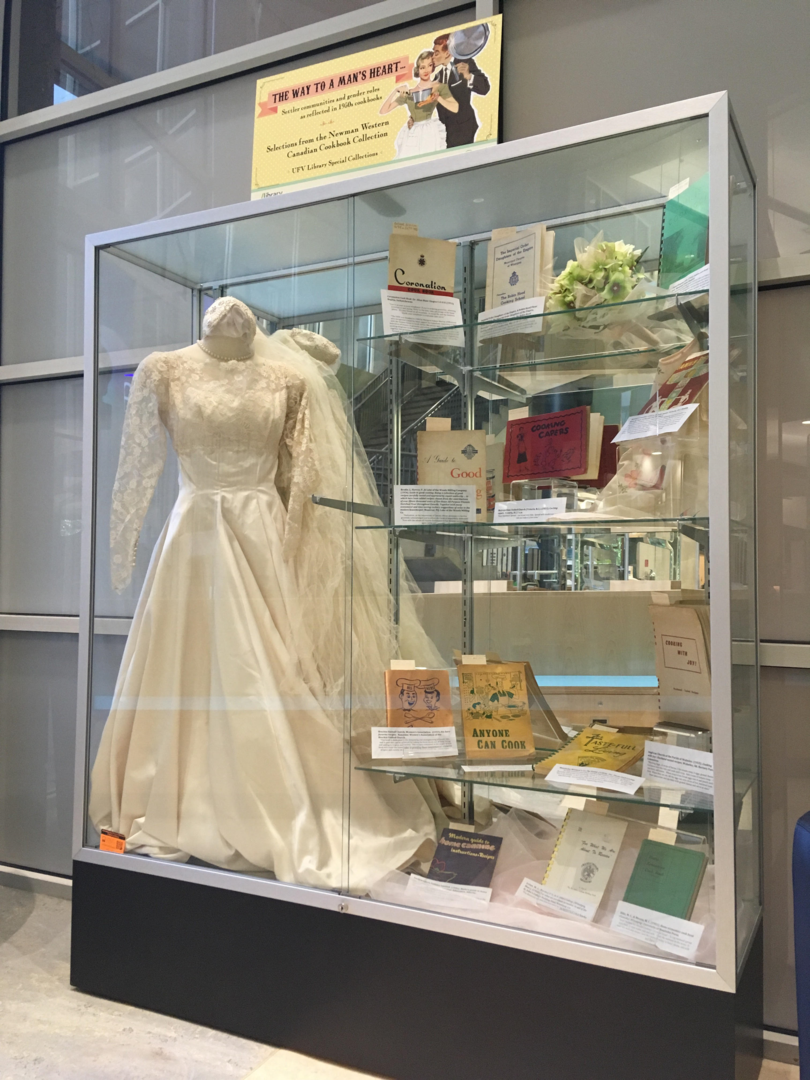When I think of the 1950s, I think of Donna Reed and Lucille Ball. I think of perfectly coiffed hair, pearl necklaces, layers of crinoline, t-strap shoes, elaborately set dinner tables, and the whole smorgasbord of options at every meal, all made from scratch. I also think of a time, where women were expected to keep their husbands happy and wore Valium smiles.
On Thursday, May 31, the UFV library debuted a contribution from the “Newman Western Canadian Cookbook Collection.” The display is an assortment of vintage cookbooks and a beautiful retro wedding dress. The exhibit is titled “The Way to a Man’s Heart”; a portion of the old adage, “The way to a man’s heart is through his stomach.”
I can’t tell you for sure if that saying is derived from any truth, however. As a long-term single woman, I can say that my cooking doesn’t seem to keep the men around. Maybe that’s because of my cooking, or maybe because there’s no veracity to the claim. I am inclined to believe the latter.
This display portrays another time, one that seems in stark contrast with current events. And yet, many of these were published within the last 60 years. That’s not a long time as far as history is concerned. Have we truly abolished all of these blatantly unequal gender roles when it comes to cooking?
According to research done by the United States Bureau of Labor, the gap of which gender spends more time in the kitchen is still apparent. Women spend 37 per cent more time than men involved in food preparation activities around the home.
And yet, there seems to be an influx of male chefs featured consistently on chef shows. Are we saying that women belong only in home kitchens, and men in professional ones?
According to author Fred Decker in an article published on the website “The Nest,” “[W]omen still account for a relatively low percentage of kitchen staff at all levels.” Decker is a trained chef educated in Canada, and published in Canada’s Hospitality and Foodservice magazine.
“Industry surveys provide an estimate, and they say women account for approximately 20 percent of respondents to the American Culinary Federation’s 2011 salary survey. Surveys in 2010 and 2011 by StarChefs reported similarly low numbers, with 396 female respondents in 2011 compared to 1,325 men,” writes Decker.
The surveys differentiated respondents by gender and job title, and it was uncovered that 16 per cent of female respondents were executive chefs and 14 per cent were CEOs or chef/owners, compared to the 38 per cent and 11 per cent of male respondents.
Overall, I think it is important to be mindful of romanticizing a time, colouring the memory of it with soft pastels and fuzzy edges, pretending that it was “simpler” or “the good ol’ days.” Sexism ran rampant during this era and people had to navigate constricting gender roles.
That is not to say, however, that looking back isn’t important, or that these books should be burned à la Fahrenheit 451. These were the books our mothers and grandmothers used. Their handwritten notes peppered the margins, and the pages were stained with sauces and remnants of meals made with love.
Instead, let’s look at these books for what they are: artifacts of a time past. Then, let us forge ahead, bucking constricting gender rules, and remembering that everyone belongs in the kitchen, because the kitchen has food, and food is good.
Image: Cat Friesen/The Cascade


